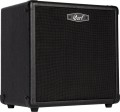Impedance
The impedance of the speaker(s) installed in the amplifier.
Impedance is the resistance to alternating current — that is, the current flowing when an audio signal is applied. This impedance affects the compatibility of the speaker with the power amplifier: if the impedance is too low, sound distortion occurs, if the impedance is too high, the volume is reduced. However, in combo amplifiers, this parameter is most often given as a purely reference: such devices have their own power amplifier, which, by definition, is designed for the impedance of the “native” speaker, and separately, with extraneous components, the speaker and amplifier are not used.
Effects
Built-in effects provided in the combo amplifier. You can also achieve various effects with the help of external “gadgets”, however, such gadgets need to be searched for and connected separately, while built-in effects are available immediately and without unnecessary settings.
—
Overdrive. Distortion in the form of a characteristic electric guitar "buzz" at low frequencies and "howl" at high frequencies, a little softer than distortion. Popular, in particular, in hard rock.
—
Distortion. Sufficiently hard and sharp distortion, similar in sound to overdrive, but more intense and brighter. It is widely used in various styles of metal, and is also found in rock.
—
Reverb. An effect based on simulating multiple decaying echoes from each sound. Depending on the duration and intensity of repetitions, it can give the sound a different colour. Used as an artistic device; among other things, it can create the effect that the guitar sounds in a certain room (concert hall, room with stone walls, an open area in the mountains, etc.). Note that the reverberation can be adjusted both by individual parameters (intensity, echo duration, etc.), and by selecting a preset set of parameters (for example, “sharp sound in the room” or “soft sound in the hall”).
—
Tremolo. Tremolo is basically a trembling effect that res
...ults from small and quick fluctuations in the volume of each note. Sometimes this term means vibrato (see below) — to the point that the manufacturers of guitar amplifiers themselves mean the effect of vibrato by the tremolo effect, and vice versa. So the specifics of this effect in each case should be clarified separately. Anyway, the tremolo can be "fixed" or adjustable in depth (range of volume change) and speed (jitter frequency).
— Vibrato. Another effect of "jerking" sound, which is often confused with tremolo (see above) — to the point that both these terms are used as identical. However, this is not true; the difference lies in the fact that vibrato is carried out due to the rapid fluctuations of the note not in volume, but in frequency. A similar effect can be achieved on the guitar itself by "pulsating" the strings, but using the amplifier's built-in instrument is much more convenient in most cases.
— Chorus. An effect designed to simulate the choral sound of an instrument. To do this, the amplifier copies the sound of the guitar and plays several copies simultaneously with the original signal, slightly shifting them in time (about 20 – 30 ms with a constant change) and frequency. However it is impossible to achieve a full-fledged choral sound in this way, but the effect is quite original in itself.
— Delay. A specific type of reverb (see "Reverb") that has become widespread as a separate effect. Delay simulates a clear single echo from the sound being played; for this, the original signal is copied and reproduced with a certain time delay (at least 50 ms).
In addition to those described above, other effects can be found in modern guitar combo amplifiers, in particular:
— Flanger. The effect is reminiscent of the whistle of a jet engine; it is often compared to a plane taking off. It is created similarly to the Chorus described above, differs from it in a shorter delay time and the presence of feedback.
— echo. Another kind of reverb, similar to delay (see “Delay”). It differs in that in this case the echo is reproduced repeatedly.
— Octaver. An effect in which a copy of it is added to the signal, shifted by an octave or two.
— Wah wah. An effect that produces a characteristic "croak" sound.Break (send/return)
The type of insert (send/return) provided in the combo amp.
In this case, a gap means
a set of connectors for connecting an effects unit between the preamplifier and the combo's power amplifier. One of these connectors (preamp output) is usually labeled “Send”, the second (power amplifier input) is labeled “Return”. With such an interface, you can connect various "gadgets" to the combo amplifier, supplementing it with effects that were not originally provided for in the design (see "Effects"). And the type of gap determines the connection format of the "gadget". The options might be:
— Consistent. The simplest connection option: the “gadget” is connected directly between the preamplifier and the power amplifier, and the entire audio signal passes through it.
— Parallel. With this type of connection, the signal at the output of the preamplifier is divided: one part goes through the "gadget", the second — bypassing it. Both streams enter the mini-mixer, where they are again combined into one signal. Such a connection scheme is more complicated and somewhat more expensive than a serial one, but it gives more opportunities: the mixer allows you to change the ratio between the original and processed signal, thus adjusting the final sound. At the same time, in many models it is possible to completely turn off the original signal and feed only the processed stream to the power amplifier, as with the series amplificatio
...n described above.
